Impact of Apple's Dividend Policy on Share Value: A Finance Report
VerifiedAdded on 2023/05/29
|17
|2929
|339
Report
AI Summary
This report examines Apple Inc.'s dividend policy since 2012 and its impact on the company's market standing. It begins by highlighting Apple's position as a leading dividend-paying company, comparing it with other S&P 500 firms. The analysis includes a review of Apple's income statements from 2014 to 2018, demonstrating consistent growth in revenue, gross profit, and net income, supporting the assertion that increased dividend payouts reflect improved financial performance. The report also discusses the company's preference for cash dividends over share repurchases, citing shareholder satisfaction and signaling effects as key factors. Furthermore, it calculates the theoretical share price using the discounted cash flow method, suggesting that the market price in 2017 was undervalued. The report concludes that Apple should consider buying back shares to capitalize on this discrepancy.

Running head: CORPORATE FINANCE
Corporate Finance
Name of the Student:
Name of the University:
Authors Note:
Corporate Finance
Name of the Student:
Name of the University:
Authors Note:
Paraphrase This Document
Need a fresh take? Get an instant paraphrase of this document with our AI Paraphraser

1
CORPORATE FINANCE
Executive summary:
Dividend is the return on investments paid to the shareholders of a company on the shares
of the said company. There is a direct relationship between the amount of dividend a company
paid and the market price of its shares. Thus, companies look to pay high amount of dividend to
the shareholders to ensure that its share price moves in the right direction. A detailed discussion
on the implications of Apple’s ever increasing dividend payout since 2012 on its market standing
is outlined below.
CORPORATE FINANCE
Executive summary:
Dividend is the return on investments paid to the shareholders of a company on the shares
of the said company. There is a direct relationship between the amount of dividend a company
paid and the market price of its shares. Thus, companies look to pay high amount of dividend to
the shareholders to ensure that its share price moves in the right direction. A detailed discussion
on the implications of Apple’s ever increasing dividend payout since 2012 on its market standing
is outlined below.
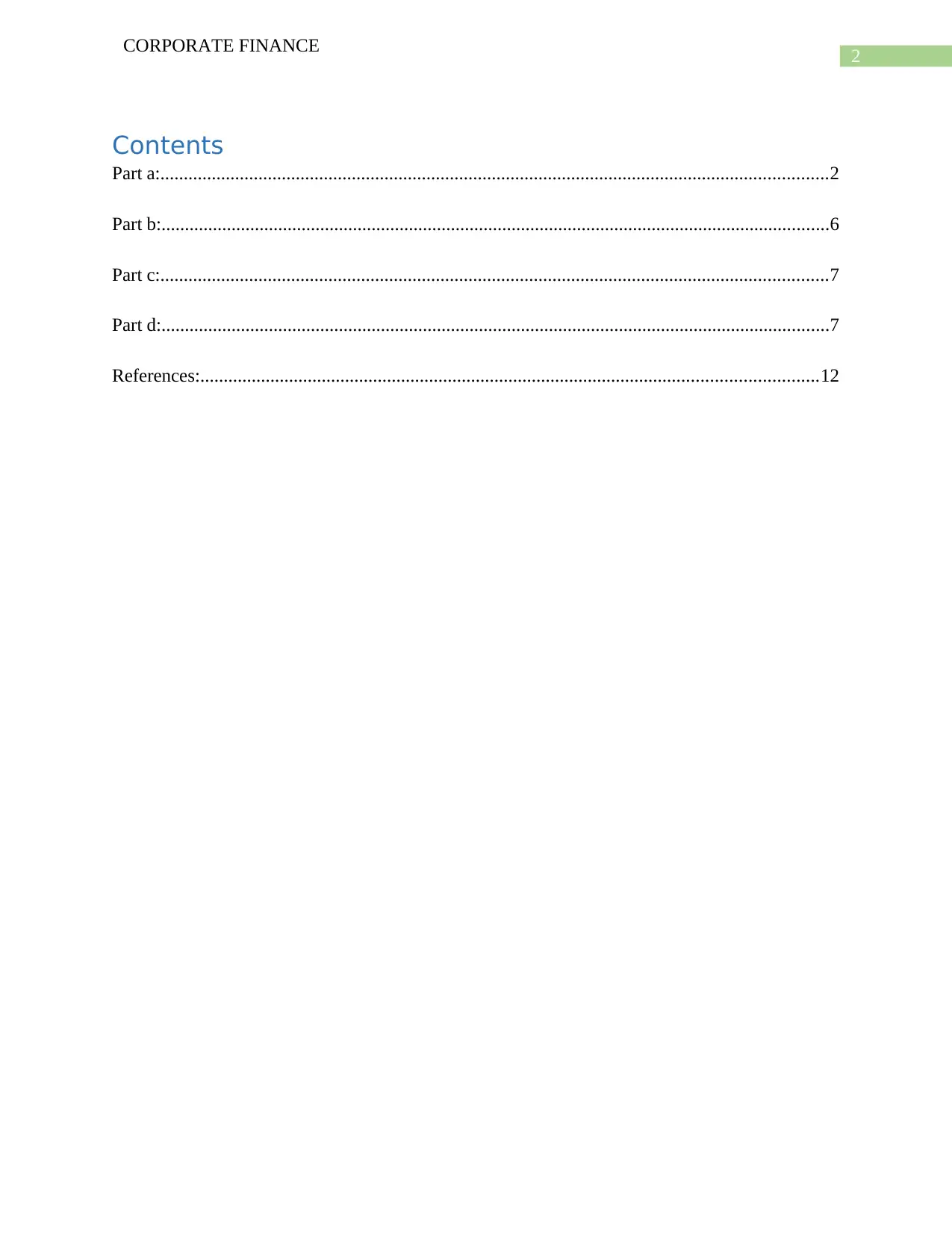
2
CORPORATE FINANCE
Contents
Part a:...............................................................................................................................................2
Part b:...............................................................................................................................................6
Part c:...............................................................................................................................................7
Part d:...............................................................................................................................................7
References:....................................................................................................................................12
CORPORATE FINANCE
Contents
Part a:...............................................................................................................................................2
Part b:...............................................................................................................................................6
Part c:...............................................................................................................................................7
Part d:...............................................................................................................................................7
References:....................................................................................................................................12
⊘ This is a preview!⊘
Do you want full access?
Subscribe today to unlock all pages.

Trusted by 1+ million students worldwide
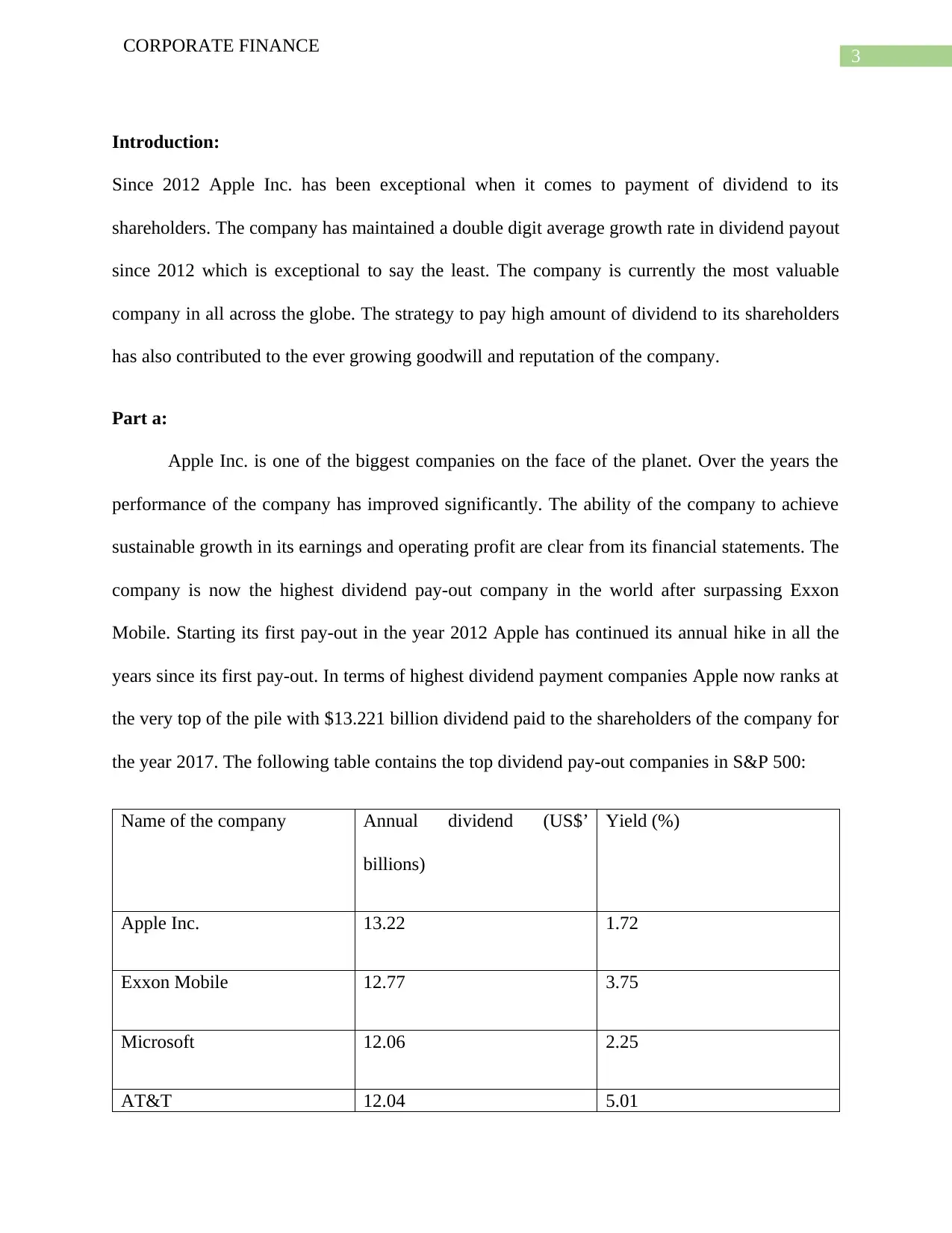
3
CORPORATE FINANCE
Introduction:
Since 2012 Apple Inc. has been exceptional when it comes to payment of dividend to its
shareholders. The company has maintained a double digit average growth rate in dividend payout
since 2012 which is exceptional to say the least. The company is currently the most valuable
company in all across the globe. The strategy to pay high amount of dividend to its shareholders
has also contributed to the ever growing goodwill and reputation of the company.
Part a:
Apple Inc. is one of the biggest companies on the face of the planet. Over the years the
performance of the company has improved significantly. The ability of the company to achieve
sustainable growth in its earnings and operating profit are clear from its financial statements. The
company is now the highest dividend pay-out company in the world after surpassing Exxon
Mobile. Starting its first pay-out in the year 2012 Apple has continued its annual hike in all the
years since its first pay-out. In terms of highest dividend payment companies Apple now ranks at
the very top of the pile with $13.221 billion dividend paid to the shareholders of the company for
the year 2017. The following table contains the top dividend pay-out companies in S&P 500:
Name of the company Annual dividend (US$’
billions)
Yield (%)
Apple Inc. 13.22 1.72
Exxon Mobile 12.77 3.75
Microsoft 12.06 2.25
AT&T 12.04 5.01
CORPORATE FINANCE
Introduction:
Since 2012 Apple Inc. has been exceptional when it comes to payment of dividend to its
shareholders. The company has maintained a double digit average growth rate in dividend payout
since 2012 which is exceptional to say the least. The company is currently the most valuable
company in all across the globe. The strategy to pay high amount of dividend to its shareholders
has also contributed to the ever growing goodwill and reputation of the company.
Part a:
Apple Inc. is one of the biggest companies on the face of the planet. Over the years the
performance of the company has improved significantly. The ability of the company to achieve
sustainable growth in its earnings and operating profit are clear from its financial statements. The
company is now the highest dividend pay-out company in the world after surpassing Exxon
Mobile. Starting its first pay-out in the year 2012 Apple has continued its annual hike in all the
years since its first pay-out. In terms of highest dividend payment companies Apple now ranks at
the very top of the pile with $13.221 billion dividend paid to the shareholders of the company for
the year 2017. The following table contains the top dividend pay-out companies in S&P 500:
Name of the company Annual dividend (US$’
billions)
Yield (%)
Apple Inc. 13.22 1.72
Exxon Mobile 12.77 3.75
Microsoft 12.06 2.25
AT&T 12.04 5.01
Paraphrase This Document
Need a fresh take? Get an instant paraphrase of this document with our AI Paraphraser
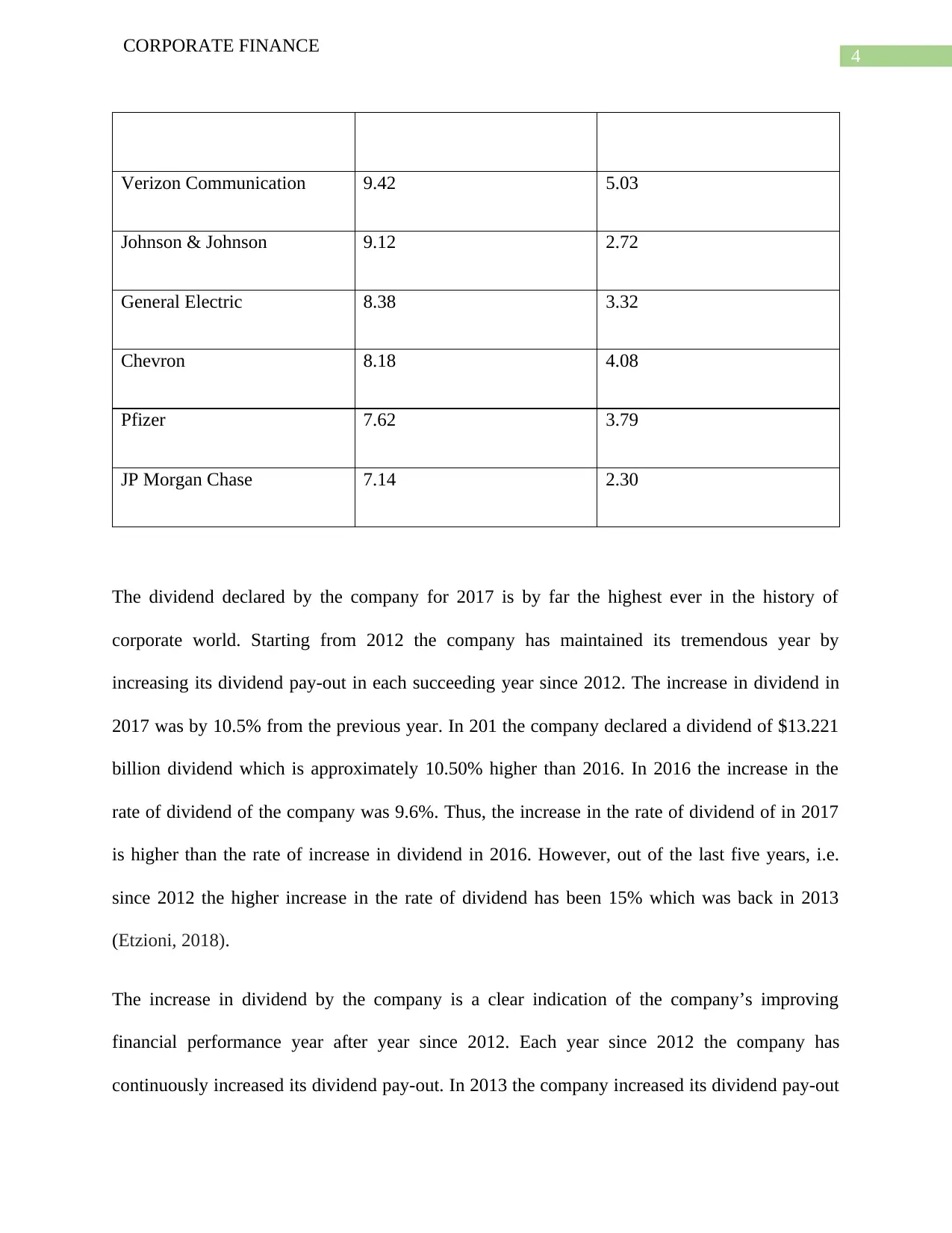
4
CORPORATE FINANCE
Verizon Communication 9.42 5.03
Johnson & Johnson 9.12 2.72
General Electric 8.38 3.32
Chevron 8.18 4.08
Pfizer 7.62 3.79
JP Morgan Chase 7.14 2.30
The dividend declared by the company for 2017 is by far the highest ever in the history of
corporate world. Starting from 2012 the company has maintained its tremendous year by
increasing its dividend pay-out in each succeeding year since 2012. The increase in dividend in
2017 was by 10.5% from the previous year. In 201 the company declared a dividend of $13.221
billion dividend which is approximately 10.50% higher than 2016. In 2016 the increase in the
rate of dividend of the company was 9.6%. Thus, the increase in the rate of dividend of in 2017
is higher than the rate of increase in dividend in 2016. However, out of the last five years, i.e.
since 2012 the higher increase in the rate of dividend has been 15% which was back in 2013
(Etzioni, 2018).
The increase in dividend by the company is a clear indication of the company’s improving
financial performance year after year since 2012. Each year since 2012 the company has
continuously increased its dividend pay-out. In 2013 the company increased its dividend pay-out
CORPORATE FINANCE
Verizon Communication 9.42 5.03
Johnson & Johnson 9.12 2.72
General Electric 8.38 3.32
Chevron 8.18 4.08
Pfizer 7.62 3.79
JP Morgan Chase 7.14 2.30
The dividend declared by the company for 2017 is by far the highest ever in the history of
corporate world. Starting from 2012 the company has maintained its tremendous year by
increasing its dividend pay-out in each succeeding year since 2012. The increase in dividend in
2017 was by 10.5% from the previous year. In 201 the company declared a dividend of $13.221
billion dividend which is approximately 10.50% higher than 2016. In 2016 the increase in the
rate of dividend of the company was 9.6%. Thus, the increase in the rate of dividend of in 2017
is higher than the rate of increase in dividend in 2016. However, out of the last five years, i.e.
since 2012 the higher increase in the rate of dividend has been 15% which was back in 2013
(Etzioni, 2018).
The increase in dividend by the company is a clear indication of the company’s improving
financial performance year after year since 2012. Each year since 2012 the company has
continuously increased its dividend pay-out. In 2013 the company increased its dividend pay-out
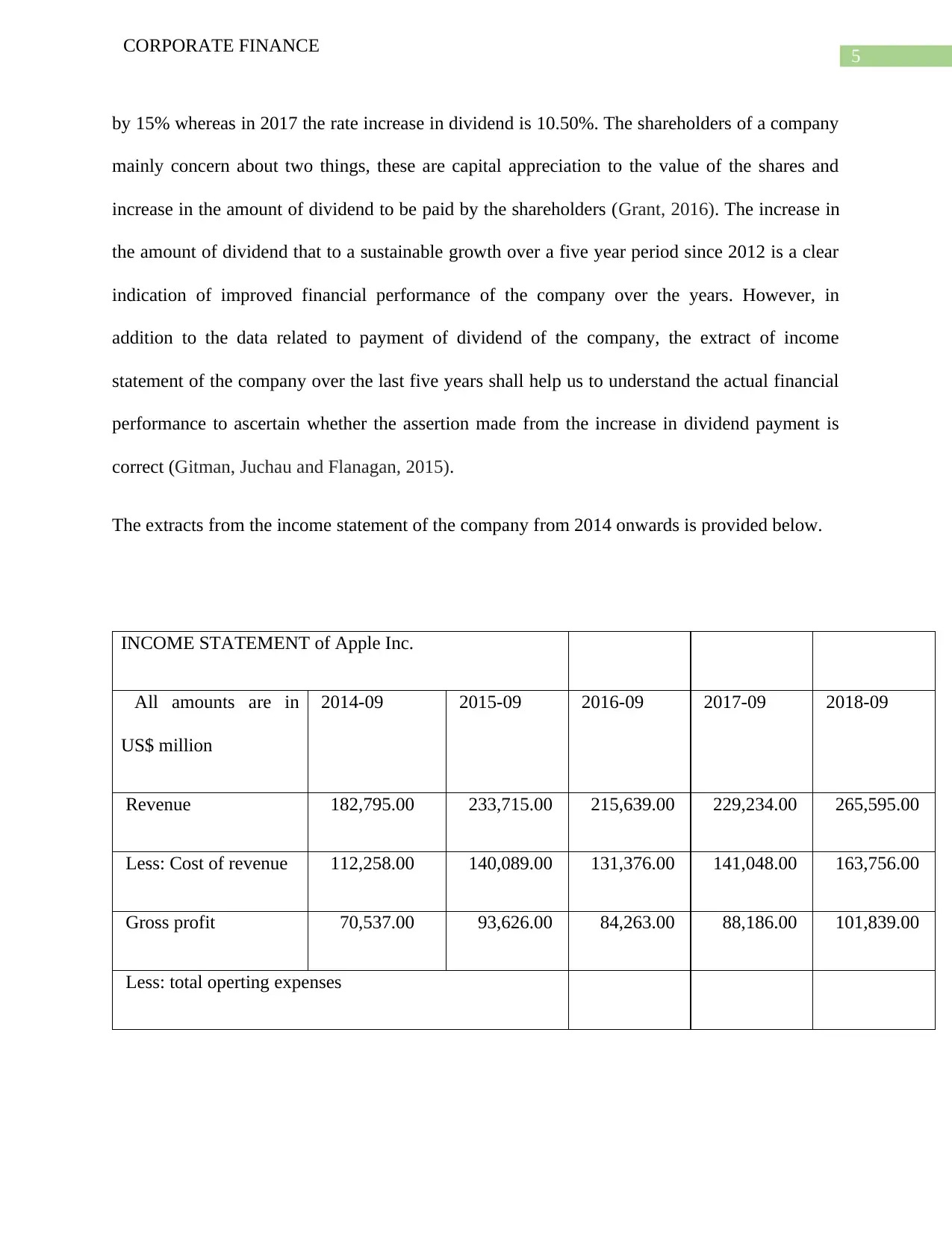
5
CORPORATE FINANCE
by 15% whereas in 2017 the rate increase in dividend is 10.50%. The shareholders of a company
mainly concern about two things, these are capital appreciation to the value of the shares and
increase in the amount of dividend to be paid by the shareholders (Grant, 2016). The increase in
the amount of dividend that to a sustainable growth over a five year period since 2012 is a clear
indication of improved financial performance of the company over the years. However, in
addition to the data related to payment of dividend of the company, the extract of income
statement of the company over the last five years shall help us to understand the actual financial
performance to ascertain whether the assertion made from the increase in dividend payment is
correct (Gitman, Juchau and Flanagan, 2015).
The extracts from the income statement of the company from 2014 onwards is provided below.
INCOME STATEMENT of Apple Inc.
All amounts are in
US$ million
2014-09 2015-09 2016-09 2017-09 2018-09
Revenue 182,795.00 233,715.00 215,639.00 229,234.00 265,595.00
Less: Cost of revenue 112,258.00 140,089.00 131,376.00 141,048.00 163,756.00
Gross profit 70,537.00 93,626.00 84,263.00 88,186.00 101,839.00
Less: total operting expenses
CORPORATE FINANCE
by 15% whereas in 2017 the rate increase in dividend is 10.50%. The shareholders of a company
mainly concern about two things, these are capital appreciation to the value of the shares and
increase in the amount of dividend to be paid by the shareholders (Grant, 2016). The increase in
the amount of dividend that to a sustainable growth over a five year period since 2012 is a clear
indication of improved financial performance of the company over the years. However, in
addition to the data related to payment of dividend of the company, the extract of income
statement of the company over the last five years shall help us to understand the actual financial
performance to ascertain whether the assertion made from the increase in dividend payment is
correct (Gitman, Juchau and Flanagan, 2015).
The extracts from the income statement of the company from 2014 onwards is provided below.
INCOME STATEMENT of Apple Inc.
All amounts are in
US$ million
2014-09 2015-09 2016-09 2017-09 2018-09
Revenue 182,795.00 233,715.00 215,639.00 229,234.00 265,595.00
Less: Cost of revenue 112,258.00 140,089.00 131,376.00 141,048.00 163,756.00
Gross profit 70,537.00 93,626.00 84,263.00 88,186.00 101,839.00
Less: total operting expenses
⊘ This is a preview!⊘
Do you want full access?
Subscribe today to unlock all pages.

Trusted by 1+ million students worldwide
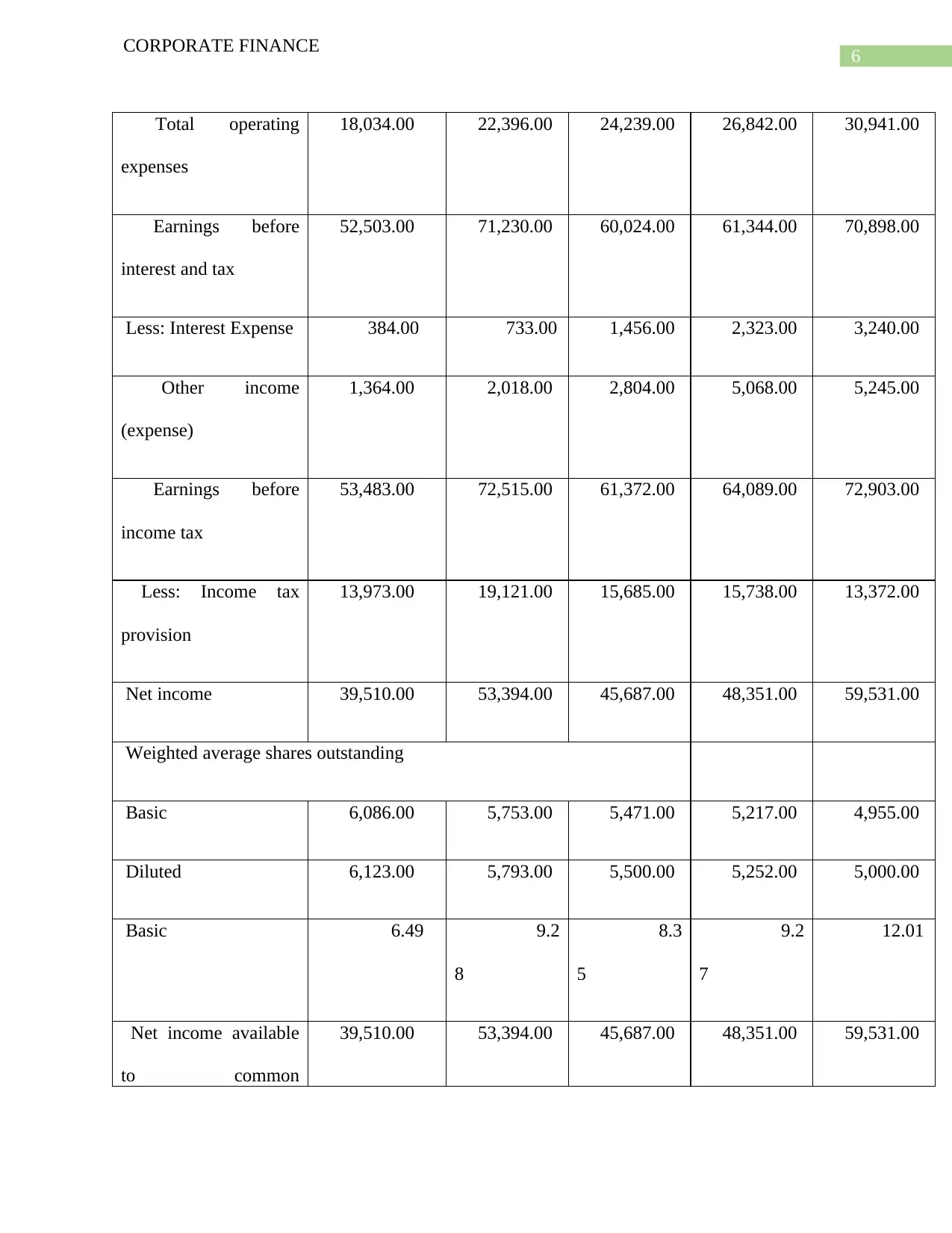
6
CORPORATE FINANCE
Total operating
expenses
18,034.00 22,396.00 24,239.00 26,842.00 30,941.00
Earnings before
interest and tax
52,503.00 71,230.00 60,024.00 61,344.00 70,898.00
Less: Interest Expense 384.00 733.00 1,456.00 2,323.00 3,240.00
Other income
(expense)
1,364.00 2,018.00 2,804.00 5,068.00 5,245.00
Earnings before
income tax
53,483.00 72,515.00 61,372.00 64,089.00 72,903.00
Less: Income tax
provision
13,973.00 19,121.00 15,685.00 15,738.00 13,372.00
Net income 39,510.00 53,394.00 45,687.00 48,351.00 59,531.00
Weighted average shares outstanding
Basic 6,086.00 5,753.00 5,471.00 5,217.00 4,955.00
Diluted 6,123.00 5,793.00 5,500.00 5,252.00 5,000.00
Basic 6.49 9.2
8
8.3
5
9.2
7
12.01
Net income available
to common
39,510.00 53,394.00 45,687.00 48,351.00 59,531.00
CORPORATE FINANCE
Total operating
expenses
18,034.00 22,396.00 24,239.00 26,842.00 30,941.00
Earnings before
interest and tax
52,503.00 71,230.00 60,024.00 61,344.00 70,898.00
Less: Interest Expense 384.00 733.00 1,456.00 2,323.00 3,240.00
Other income
(expense)
1,364.00 2,018.00 2,804.00 5,068.00 5,245.00
Earnings before
income tax
53,483.00 72,515.00 61,372.00 64,089.00 72,903.00
Less: Income tax
provision
13,973.00 19,121.00 15,685.00 15,738.00 13,372.00
Net income 39,510.00 53,394.00 45,687.00 48,351.00 59,531.00
Weighted average shares outstanding
Basic 6,086.00 5,753.00 5,471.00 5,217.00 4,955.00
Diluted 6,123.00 5,793.00 5,500.00 5,252.00 5,000.00
Basic 6.49 9.2
8
8.3
5
9.2
7
12.01
Net income available
to common
39,510.00 53,394.00 45,687.00 48,351.00 59,531.00
Paraphrase This Document
Need a fresh take? Get an instant paraphrase of this document with our AI Paraphraser
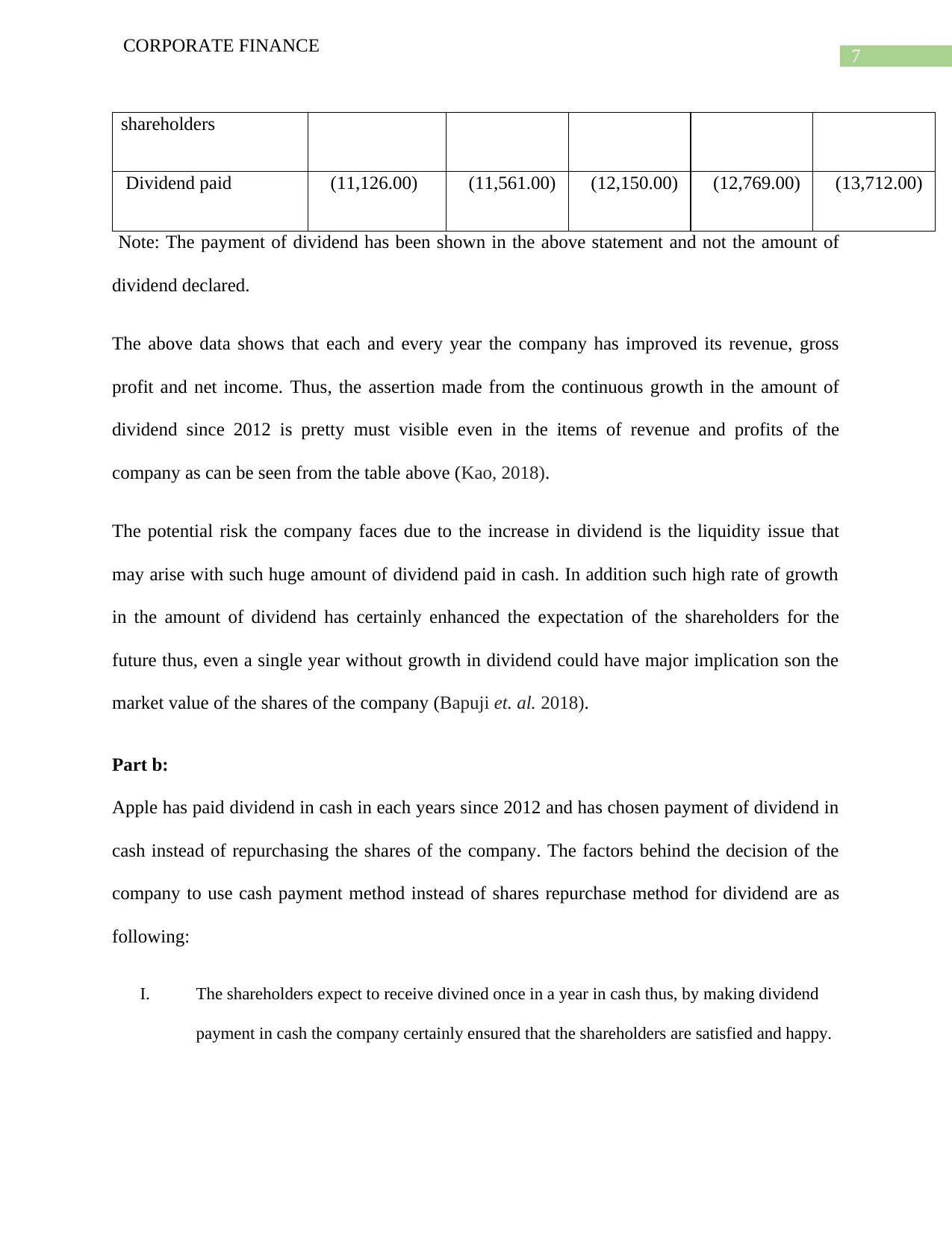
7
CORPORATE FINANCE
shareholders
Dividend paid (11,126.00) (11,561.00) (12,150.00) (12,769.00) (13,712.00)
Note: The payment of dividend has been shown in the above statement and not the amount of
dividend declared.
The above data shows that each and every year the company has improved its revenue, gross
profit and net income. Thus, the assertion made from the continuous growth in the amount of
dividend since 2012 is pretty must visible even in the items of revenue and profits of the
company as can be seen from the table above (Kao, 2018).
The potential risk the company faces due to the increase in dividend is the liquidity issue that
may arise with such huge amount of dividend paid in cash. In addition such high rate of growth
in the amount of dividend has certainly enhanced the expectation of the shareholders for the
future thus, even a single year without growth in dividend could have major implication son the
market value of the shares of the company (Bapuji et. al. 2018).
Part b:
Apple has paid dividend in cash in each years since 2012 and has chosen payment of dividend in
cash instead of repurchasing the shares of the company. The factors behind the decision of the
company to use cash payment method instead of shares repurchase method for dividend are as
following:
I. The shareholders expect to receive divined once in a year in cash thus, by making dividend
payment in cash the company certainly ensured that the shareholders are satisfied and happy.
CORPORATE FINANCE
shareholders
Dividend paid (11,126.00) (11,561.00) (12,150.00) (12,769.00) (13,712.00)
Note: The payment of dividend has been shown in the above statement and not the amount of
dividend declared.
The above data shows that each and every year the company has improved its revenue, gross
profit and net income. Thus, the assertion made from the continuous growth in the amount of
dividend since 2012 is pretty must visible even in the items of revenue and profits of the
company as can be seen from the table above (Kao, 2018).
The potential risk the company faces due to the increase in dividend is the liquidity issue that
may arise with such huge amount of dividend paid in cash. In addition such high rate of growth
in the amount of dividend has certainly enhanced the expectation of the shareholders for the
future thus, even a single year without growth in dividend could have major implication son the
market value of the shares of the company (Bapuji et. al. 2018).
Part b:
Apple has paid dividend in cash in each years since 2012 and has chosen payment of dividend in
cash instead of repurchasing the shares of the company. The factors behind the decision of the
company to use cash payment method instead of shares repurchase method for dividend are as
following:
I. The shareholders expect to receive divined once in a year in cash thus, by making dividend
payment in cash the company certainly ensured that the shareholders are satisfied and happy.
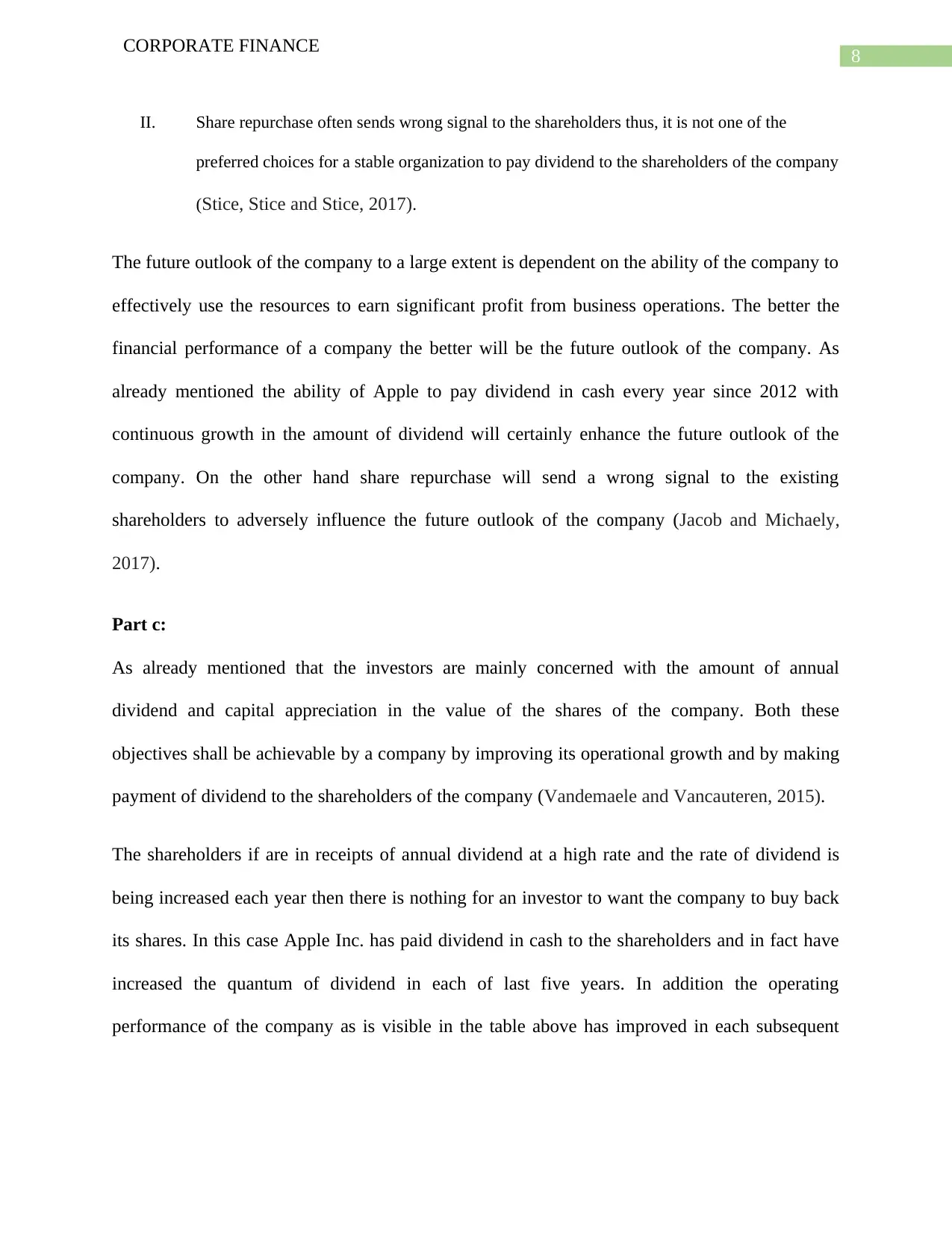
8
CORPORATE FINANCE
II. Share repurchase often sends wrong signal to the shareholders thus, it is not one of the
preferred choices for a stable organization to pay dividend to the shareholders of the company
(Stice, Stice and Stice, 2017).
The future outlook of the company to a large extent is dependent on the ability of the company to
effectively use the resources to earn significant profit from business operations. The better the
financial performance of a company the better will be the future outlook of the company. As
already mentioned the ability of Apple to pay dividend in cash every year since 2012 with
continuous growth in the amount of dividend will certainly enhance the future outlook of the
company. On the other hand share repurchase will send a wrong signal to the existing
shareholders to adversely influence the future outlook of the company (Jacob and Michaely,
2017).
Part c:
As already mentioned that the investors are mainly concerned with the amount of annual
dividend and capital appreciation in the value of the shares of the company. Both these
objectives shall be achievable by a company by improving its operational growth and by making
payment of dividend to the shareholders of the company (Vandemaele and Vancauteren, 2015).
The shareholders if are in receipts of annual dividend at a high rate and the rate of dividend is
being increased each year then there is nothing for an investor to want the company to buy back
its shares. In this case Apple Inc. has paid dividend in cash to the shareholders and in fact have
increased the quantum of dividend in each of last five years. In addition the operating
performance of the company as is visible in the table above has improved in each subsequent
CORPORATE FINANCE
II. Share repurchase often sends wrong signal to the shareholders thus, it is not one of the
preferred choices for a stable organization to pay dividend to the shareholders of the company
(Stice, Stice and Stice, 2017).
The future outlook of the company to a large extent is dependent on the ability of the company to
effectively use the resources to earn significant profit from business operations. The better the
financial performance of a company the better will be the future outlook of the company. As
already mentioned the ability of Apple to pay dividend in cash every year since 2012 with
continuous growth in the amount of dividend will certainly enhance the future outlook of the
company. On the other hand share repurchase will send a wrong signal to the existing
shareholders to adversely influence the future outlook of the company (Jacob and Michaely,
2017).
Part c:
As already mentioned that the investors are mainly concerned with the amount of annual
dividend and capital appreciation in the value of the shares of the company. Both these
objectives shall be achievable by a company by improving its operational growth and by making
payment of dividend to the shareholders of the company (Vandemaele and Vancauteren, 2015).
The shareholders if are in receipts of annual dividend at a high rate and the rate of dividend is
being increased each year then there is nothing for an investor to want the company to buy back
its shares. In this case Apple Inc. has paid dividend in cash to the shareholders and in fact have
increased the quantum of dividend in each of last five years. In addition the operating
performance of the company as is visible in the table above has improved in each subsequent
⊘ This is a preview!⊘
Do you want full access?
Subscribe today to unlock all pages.

Trusted by 1+ million students worldwide
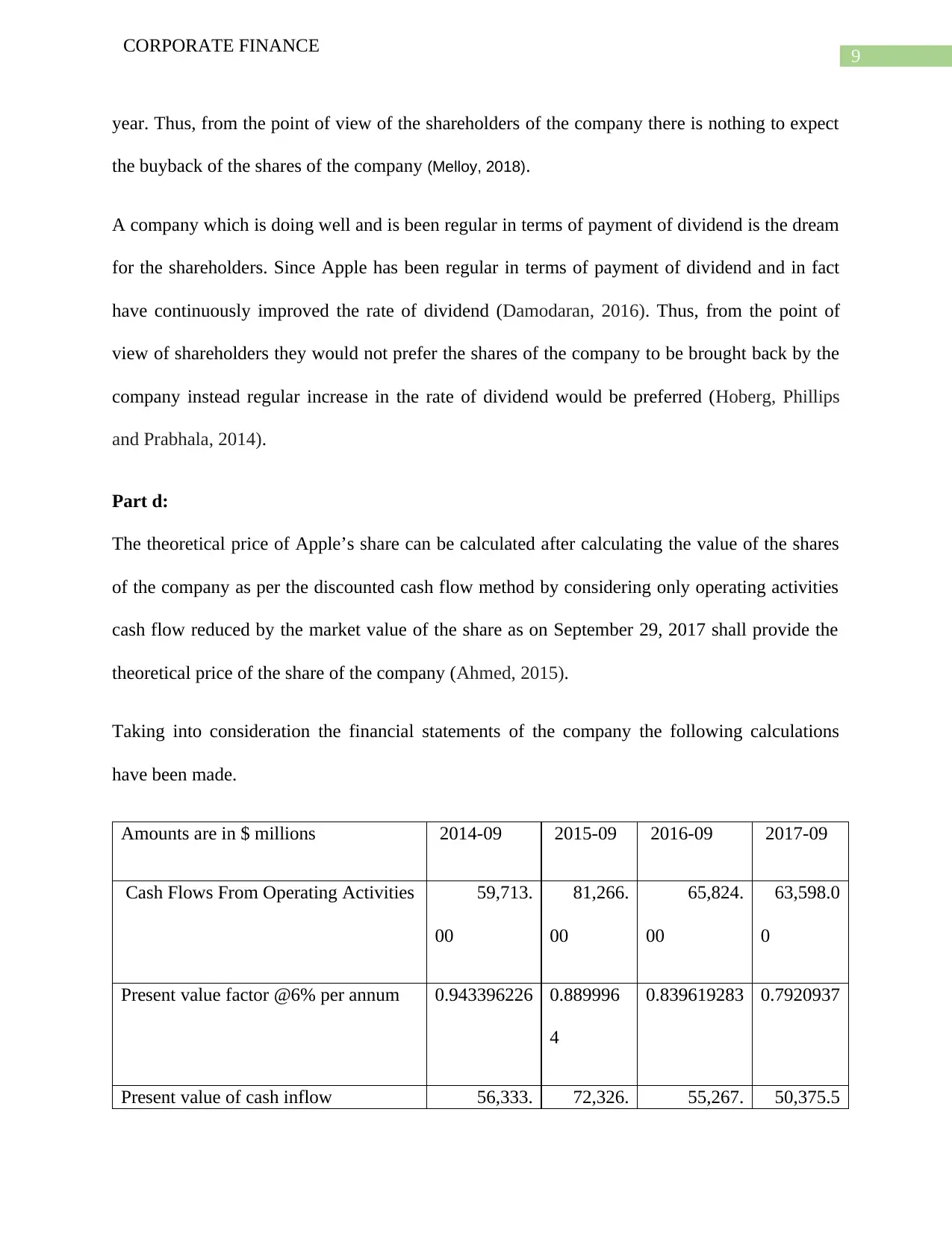
9
CORPORATE FINANCE
year. Thus, from the point of view of the shareholders of the company there is nothing to expect
the buyback of the shares of the company (Melloy, 2018).
A company which is doing well and is been regular in terms of payment of dividend is the dream
for the shareholders. Since Apple has been regular in terms of payment of dividend and in fact
have continuously improved the rate of dividend (Damodaran, 2016). Thus, from the point of
view of shareholders they would not prefer the shares of the company to be brought back by the
company instead regular increase in the rate of dividend would be preferred (Hoberg, Phillips
and Prabhala, 2014).
Part d:
The theoretical price of Apple’s share can be calculated after calculating the value of the shares
of the company as per the discounted cash flow method by considering only operating activities
cash flow reduced by the market value of the share as on September 29, 2017 shall provide the
theoretical price of the share of the company (Ahmed, 2015).
Taking into consideration the financial statements of the company the following calculations
have been made.
Amounts are in $ millions 2014-09 2015-09 2016-09 2017-09
Cash Flows From Operating Activities 59,713.
00
81,266.
00
65,824.
00
63,598.0
0
Present value factor @6% per annum 0.943396226 0.889996
4
0.839619283 0.7920937
Present value of cash inflow 56,333. 72,326. 55,267. 50,375.5
CORPORATE FINANCE
year. Thus, from the point of view of the shareholders of the company there is nothing to expect
the buyback of the shares of the company (Melloy, 2018).
A company which is doing well and is been regular in terms of payment of dividend is the dream
for the shareholders. Since Apple has been regular in terms of payment of dividend and in fact
have continuously improved the rate of dividend (Damodaran, 2016). Thus, from the point of
view of shareholders they would not prefer the shares of the company to be brought back by the
company instead regular increase in the rate of dividend would be preferred (Hoberg, Phillips
and Prabhala, 2014).
Part d:
The theoretical price of Apple’s share can be calculated after calculating the value of the shares
of the company as per the discounted cash flow method by considering only operating activities
cash flow reduced by the market value of the share as on September 29, 2017 shall provide the
theoretical price of the share of the company (Ahmed, 2015).
Taking into consideration the financial statements of the company the following calculations
have been made.
Amounts are in $ millions 2014-09 2015-09 2016-09 2017-09
Cash Flows From Operating Activities 59,713.
00
81,266.
00
65,824.
00
63,598.0
0
Present value factor @6% per annum 0.943396226 0.889996
4
0.839619283 0.7920937
Present value of cash inflow 56,333. 72,326. 55,267. 50,375.5
Paraphrase This Document
Need a fresh take? Get an instant paraphrase of this document with our AI Paraphraser

10
CORPORATE FINANCE
02 45 10 7
Growth rate (g) calculation:
Amounts are in $ millions 2014-09 2015-09 2016-09 2017-09 2018-09
Free cash flow 49,900.
00
69,778.
00
52,276.
00
50,803
.00
64,121.
00
Increase in dividend in last five
years
14,221.
00
Annual growth in free cash
flow 7.12%
Growth rate (g) = 7.12% thus, with discounting rate (r) assuming at 7.12% the following
equation can be formed g – r = 0.
Note:
APPLE INC
Amounts are in $
millions
2014-09 2015-09 2016-09 2017-09
Cash Flows From Operating Activities
Net income 39,510. 53,394. 45,687. 48,351.0
CORPORATE FINANCE
02 45 10 7
Growth rate (g) calculation:
Amounts are in $ millions 2014-09 2015-09 2016-09 2017-09 2018-09
Free cash flow 49,900.
00
69,778.
00
52,276.
00
50,803
.00
64,121.
00
Increase in dividend in last five
years
14,221.
00
Annual growth in free cash
flow 7.12%
Growth rate (g) = 7.12% thus, with discounting rate (r) assuming at 7.12% the following
equation can be formed g – r = 0.
Note:
APPLE INC
Amounts are in $
millions
2014-09 2015-09 2016-09 2017-09
Cash Flows From Operating Activities
Net income 39,510. 53,394. 45,687. 48,351.0

11
CORPORATE FINANCE
00 00 00 0
Depreciation &
amortization
7,946.
00
11,257.
00
10,505.
00
10,157.0
0
Deferred income
taxes
2,347.
00
1,382.
00
4,938.
00
5,966.
00
Stock based
compensation
2,863.
00
3,586.
00
4,210.
00
4,840.
00
Change in
working capital
7,047.
00
11,647.
00
484.
00
(5,550.0
0)
Accounts
receivable
(4,232.0
0)
611.
00
1,095.
00
(2,093.0
0)
Inventory (76.
00)
(238.
00)
217.
00
(2,723.0
0)
Accounts payable 5,938.
00
5,400.
00
1,791.
00
9,618.
00
Other working
capital
5,417.
00
5,874.
00
(2,619.0
0)
(10,352.0
0)
Other non-cash items (166.0
0)
Net cash provided 59,713. 81,266. 65,824. 63,598.0
CORPORATE FINANCE
00 00 00 0
Depreciation &
amortization
7,946.
00
11,257.
00
10,505.
00
10,157.0
0
Deferred income
taxes
2,347.
00
1,382.
00
4,938.
00
5,966.
00
Stock based
compensation
2,863.
00
3,586.
00
4,210.
00
4,840.
00
Change in
working capital
7,047.
00
11,647.
00
484.
00
(5,550.0
0)
Accounts
receivable
(4,232.0
0)
611.
00
1,095.
00
(2,093.0
0)
Inventory (76.
00)
(238.
00)
217.
00
(2,723.0
0)
Accounts payable 5,938.
00
5,400.
00
1,791.
00
9,618.
00
Other working
capital
5,417.
00
5,874.
00
(2,619.0
0)
(10,352.0
0)
Other non-cash items (166.0
0)
Net cash provided 59,713. 81,266. 65,824. 63,598.0
⊘ This is a preview!⊘
Do you want full access?
Subscribe today to unlock all pages.

Trusted by 1+ million students worldwide
1 out of 17
Related Documents
Your All-in-One AI-Powered Toolkit for Academic Success.
+13062052269
info@desklib.com
Available 24*7 on WhatsApp / Email
![[object Object]](/_next/static/media/star-bottom.7253800d.svg)
Unlock your academic potential
Copyright © 2020–2026 A2Z Services. All Rights Reserved. Developed and managed by ZUCOL.





